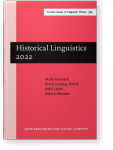Morphosyntactic borrowing in closely related varieties
‘False cognates’ in Swahili
The paper examines contact-induced morphosyntactic change in Swahili, where material which had
historically been lost is ‘reintroduced’ through contact with closely related languages which have retained the original
feature. The paper discusses three examples of these morphosyntactic ‘false cognates’: diminutive marking, habitual marking
and demonstrative forms, and shows that if it were not from the evidence from different diachronic stages and varieties of
Swahili, these forms could well be analysed as inherited from the reconstructed Proto-Bantu. The paper contributes to our
understanding of the historical development of Swahili, patterns of variation found in Swahili and Bantu languages more
widely, as well as the importance of comparative evidence for the unravelling of historical and contemporary relations between
closely related linguistic varieties.
Article outline
- 1.Introduction
- 2.Bantu languages
- 3.Cognacy, reconstruction, borrowing and convergence
- 4.Swahili
- 5.Morphosyntactic ‘reintroduction’
- 5.1The habitual -ag-
- 5.2The diminutive ka-
- 5.3The fourth demonstrative series -no
- 6.Conclusions
-
Acknowledgements
-
Abbreviations
-
References
This content is being prepared for publication; it may be subject to changes.
